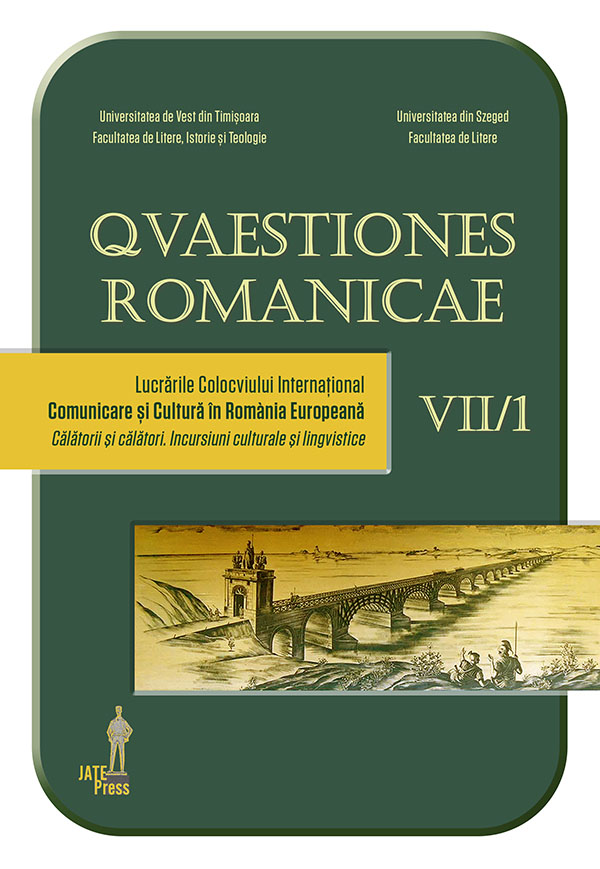Călătorie romană: de la călătoria eroică din Eneida, la rătăcirea erotică din Satyricon
Abstract: (Roman journeys: from the heroic journey in Aeneid to the erotic wander of Satyricon) Pivotal works of the Latin literature, Vergil’s Aeneid and Petronius’ Satyricon also feature the symbolic coagulation process of the Roman self-image and, ultimately, its disintegration. Centered on such fundamental topics as the journey, the heroism and the erotism, both literary productions judiciously profile a mental and imaginary journey into the Roman world, underpinning the internal dynamics that transplants the Greek cultural model, and satirically deconstructs the motif of heroism. Triumphant over the struggle against the erotism in Aeneid (Aeneas’ inner conflict between the self-accomplishment mission and his passion for Dido), the concept of heroism disintegrates ludicrously in Satyricon, in the shape of a wandering and sterile erotism, as autoerotism and narcissism. The transit from Aeneas’ focused journey towards self- accomplishment to Satyricon’s wandering reflects the disintegration of the ancient journey-archetype in general, and, of the Roman journey (of self-discovery) in particular. This bond between a classical Latin masterpiece and an anti-classical (decadent) masterpiece via resonant thematic and imaginary nuclei of the ancient world, such as the topos of the journey, would function as an essential imagological filter. Furthermore, the link between the journey, the heroism and the erotism reveals an exhaustive approach to subjectivity, a conflux of Latin literature extremes highly relevant for particular ruptures and dysfunctions. The force with which Dido, abandoned by Aeneas, collapses in the name of heroism and virtue is almost inversely proportional to the autoerotic dispersion force in Satyricon.
Keywords: journey, heroism, erotism, mentality, imagination.
Rezumat: Opere fundamentale în spaţiul literaturii latine, Eneida lui Vergiliu şi Satyricon-ul lui Petronius sunt totodată reprezentative pentru procesul coagulării simbolice a imaginii de sine romane, respectiv pentru dezintegrarea acestei imagini. Ambele centrate pe tema călătoriei şi, implicit, a eroismului şi erotismului, aceste producţii literare sunt relevante pentru surprinderea unei călătorii mentalitare şi imaginare în lumea romană, a unei dinamici interne a transplantării modelului cultural (grec) şi a deconstrucţiei satirice a eroismului ca model. Triumfător în lupta cu erotismul în Eneida (conflictul dintre misiunea fondatoare a lui Eneas şi pasiunea pentru Didona), eroismul se dezintegrează parodic în Satyricon sub triumful erotismului rătăcitor şi steril, a autoerotismului şi narcisismului. Drumul de la călătoria fondatoare, centrată, a lui Eneas la rătăcirea din Satyricon reflectă dezintegrarea arhetipului călătoriei antice în general şi a călătoriei romane (spre sine) în special. Acest paralelism între o capodoperă clasică a latinităţii şi o capodoperă anti-clasică (decadentă) prin intermediul unor nuclee tematice şi imaginare de rezonanţă în antichitate, precum toposul călătoriei, poate fi un filtru imagologic important. Mai mult, conexiunea dintre călătorie, eroism şi erotism dezvăluie o întreagă concepţie asupra subiectivităţii, iar reunirea acestor extreme în literatura latină este relevantă pentru anumite rupturi şi disfuncţii. Forţa cu care Didona, abandonată de către Eneas, se prăbuşeşte în numele eroismului şi virtuţii este aproape invers proporţională cu forţa de dispersie autoerotică din Satyricon.
Cuvinte-cheie: călătorie, eroism, erotism, mentalitate, imaginar.
